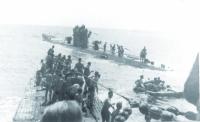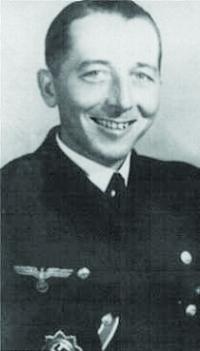This week, 70 years ago, the RMS Laconia was sunk by U-156, commanded by Kapitänleutnant Werner Hartenstein, off the west coast of Africa, between Liberia and Ascension Island.
The Laconia had begun life as a Cunard ocean liner in 1922. The ship was 601' 3" long with a beam of 73', 7". She made her maiden voyage on May 25, 1922 from Southampton to New York. Ironically, she was named for the ship of the same name, which had been sunk by a German U-boat during World War I.
In January of 1923 the Laconia made the first around-the-world cruise, which lasted 120 days and called at 22 ports.
On the day after the United Kingdom declared war on the German Reich, Laconia was drafted into service and, during January 1940, was converted into an armed merchant cruiser. She was sporting eight 6" guns and two 3" guns.
Work was begun to convert the Laconia to a Troop Transport Ship on September 12, 1941. The ship returned to service in early 1942. On September 12, 1942, the Laconia was traveling from Cape Town, in South Africa, to Freetown in Sierra Leone. She was carrying 1,800 Italian prisoners of war who were being guarded by 160 Polish soldiers. In addition to the crew, there were 268 British soldiers and 80 civilians aboard. At 8:10 p.m., the Laconia was hit on the starboard side by a torpedo fired by the German submarine. Many of the Italians were killed instantly.
Just as the Laconia’s captain, Rudolph Sharp, was gaining control over the situation, the second torpedo struck the beleaguered ship. Some of the 32 lifeboats had been destroyed. At 9:11 p.m. the Laconia sank with the Captain and many of the Italians still aboard.
When Captain Hartenstein realized that civilians and Italian POWs were on board, he surfaced and began rescue operations. When Hartenstein radioed his intent to U-boat Command, U-boat Chief, Admiral Karl Dönitz, ordered U-506, commanded by Kapitänleutnant Eric Würdemann, and U-507, commanded by Korvettenkapitän Harro Schacht, to assist. The next day, the Italian submarine Comandante Capallini, commanded by Mark Revedin, on patrol off Freetown, received orders to proceed 700 miles to assist in the rescue operations. U-156 took nearly 200 survivors aboard its deck, and had another 200 under tow in four life boats. In addition, the captain and crew did what they could for the remaining survivors in some 20 lifeboats and a number of small rafts.
At 6:00 a.m. on September 13th, Captain Hartenstein broadcast a message, in English, to all ships in the area requesting assistance and promising not to attack. By the afternoon of September 15, the two German submarines and the Comandante Capallini, had joined him and also began towing life boats, with several hundred other survivors standing on their decks. Meanwhile, the Vichy French dispatched light cruiser Gloirie, sloop Dumont d’Urville and the Annamite from French West Africa. On September 16th at 11:25 a.m., the four submarines with Red Cross flags draped across their gun decks were spotted by an American B-24 Liberator, piloted by Lt. James D. Harden. The plane was from an American base on Ascension Island.
Lt. Harden reported his finding to Capt. Robert C. Richardson III, who was the senior officer on duty that day, who ordered the lieutenant to attack and sink the enemy. At 12:32 P.M. the B-24 commenced its attack. The submarines cast adrift the lifeboats and ordered the survivors on their decks into the water and dived. Finally, the next day, the French ships arrived and were able to rescue about 1,000 of the survivors. In all, some 1,500 of Laconia’s passengers survived. That day, Captain Hartenstein was awarded the Knight’s Cross.
At the time, the sinking of the Laconia was the second worst disaster in maritime history. The number one place was the sinking of the Lancastria on June 17, 1940 in Saint Nazaire Harbor in France, by the Luftwaffe. More than 4,000 were lost. Ironically, Captain Sharp was in command that day, as well.
As a result of "The Laconia Incident," Admiral Dönitz issued "The Laconia Order," which read:
"(1) All efforts to save survivors of sunken ships, such as the fishing out of swimming men and putting them on board life boats, the righting of overturned lifeboats, or the handing over of food and water, must stop. Rescue contradicts the most basic demands of the war - the destruction of hostile ships and their crews;
(2) the orders concerning the bringing in of skippers and Chief Engineers stay in effect;
(3) survivors are to be saved only if their statements are important for the boat;
(4) stay firm. Remember that the enemy has no regard for women and children when bombing German cities!"
The "Laconia Order" was introduced by the prosecution against Admiral Dönitz at the trial in Nüremberg. The Nüremberg Tribunal held that,
"The prosecution has introduced much evidence surrounding two orders of Dönitz - War Order No. 154 issued in 1939, and the so-called Laconia Order of 1942. The Defense argues that these Orders and the evidence supporting them do not show such a policy and introduce much evidence to the contrary. The Tribunal is of the opinion that the evidence does not establish with a certainty required that Dönitz deliberately ordered the killing of shipwrecked survivors. The Orders were undoubtedly ambiguous and deserve the strongest censure. The evidence further shows that the rescue provisions were not carried out and that the Defendant ordered that they should not be carried out. The argument of the Defendant is that the security of the submarine is, as the first rule of the sea, paramount to rescue and the development of aircraft made rescue impossible. This may be so, but the Protocol is explicit. If the Commander cannot rescue, then under its term, he cannot sink a Merchant vessel and should allow it to pass harmlessly before its periscope. The orders, then, proved Dönitz is guilty of a violation of the Protocol. In view of the facts proved, and in particular of an Order of the British Admiralty, announced on 8 May 1940, according to which all vessels should be sunk at sight in the Skagerrak, and the Answers to Interrogatories by Admiral Chester Nimitz stating unrestricted submarine warfare was carried on in the Pacific Ocean by the United States from the first day of the Pacific War, the sentence of Dönitz is not assessed on the ground of the breaches of the International Law of Submarine Warfare."
With that, the Admiral’s life was spared, and he was sentenced to 20 years in Spandau Prison, of which he served half.
Captain Hartenstein was not so fortunate. Although, after the sinking of the Laconia, he had been offered a safe, cushy, desk job, he declined, preferring to continue in the submarine service. On March 8, 1943, while on patrol near Barbados, U-156 was sunk, taking the captain and all hands.
NEXT WEEK: STALINGRAD!
Mr. Wimbrow writes from Ocean City, Maryland, where he practices law representing those persons accused of criminal and traffic offenses, and those persons who have suffered a personal injury through no fault of their own. ? Mr. Wimbrow can be contacted at
wimbrowlaw@gmail.com



